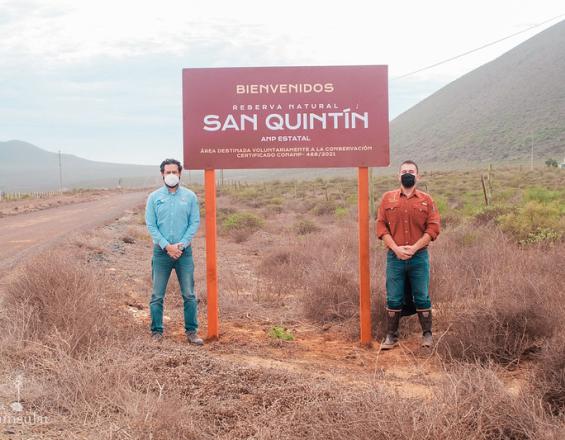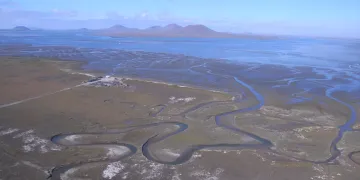César Guerrero, Executive Director of Terra Peninsular, San Quintín Bay, México is joined in this conversation by Cécile Fattebert of the IUCN Protected and Conserved Areas team.
What makes your solution successful, in a nutshell?
Our solution “Reserva Natural de San Quintín para Todos” works for the benefits of communities. We work in the Northwest of Mexico, in San Quintin Bay, which is one of the most important wetland zones of the Pacific coast of the North American continent. It is one of the most preserved wetland zones, not only in Mexico, but also of the Pacific coast of the US and Canada. It is an exceptional place.
Our project seeks to find solutions that combine the work of Natural Protected Areas creation, the legal frameworks and instruments that foster the protection of these habitats of international importance, together with the management framework of these habitats. It is important to lay the legal document of these areas, but it is also important to manage them. The ecosystems services need to be managed adequately. And lastly, but most importantly, our project involves the communities. We work with the communities. We believe that it is impossible to talk about resilience and sustainability without involving the inhabitants, residents or users of these Natural Protected Areas.
Our project seeks to conjugate these three axes.
And how do you engage the communities?
We involve communities in environmental education. It is very important for us. We celebrate some festivals, activities of exchange of experiences among communities. But it is also very important for us to work with the community who is economically active, meaning producers, farmers, aqua culturists, entrepreneurs, tourism operators. This year, with everything brought by the COVID, we have many more visitors in our Reserve. We work with them, involving the economic activities in the conservation project, so that the use of the resources is different and so that we don’t stay in the old paradigm that says that conservation and development are in opposite directions.
What benefits have you collected being a finalist of the Biodiversity Conservation category of the Pathfinder Award?
There are many benefits that I could say about being a finalist in this Pathfinder Award. Not only because it is a pat on the shoulder, it is a “you’re doing a great work!”, but it is also very important to know that we are recognized for our work. We also feel that we are not alone, and that there are others who are also interested, from other parts of the world, in attempting to save the resources and the biodiversity. Also, more than the pat on the shoulder, it is important for us to share and hear from the experiences of other places and make our project visible by letting the world know about San Quintin Bay. It is important that the world knows about the Northwest of Mexico. That the world understands the importance of its conservation. And, this is a very important point, that we all share this with the communities, with the enterprises, etc. That they see that what they have in San Quintin is something that is recognized internationally. That there is an international community, who knows and recognizes that the San Quintin Bay in the Northwest of Mexico got a medal of international importance. This is a big benefit.
What is your vision for the Natural Reserve San Quinin’s future? From what I understand, from the map provided by the solution, it is one very big area. There must be many villages, communities, stakeholders living in that area.
Our dream is that the San Quintin Bay is a world class example of conservation. And you are right, it is a very big space, with a very important wetland, and with many actors as well, with many different opinions. Our dream and vision for the future is to reach the integration of the economic activities, meaning the agriculture, the aquaculture, tourism, recreational fishing, commercial fishing with the conservation project. And I believe we’re reaching it. Today, the aquaculture in the San Quintin, depends greatly on the ecological health of the Bay, and it recognizes that. Now the oyster farmers understand it. The recreational fishers depend a lot on a healthy bay. And they understand it. Our long-term vision, and our efforts done on these three axes, seek to integrate this in a resilient project, that works not only for the natural environment, but for the economic resilience of the communities.
It is great that they understand that! It is something important for the whole planet! But how do you communicate in that area with so many stakeholders so that all share the same vision?
It is a very difficult work. A lot of our efforts are put in meetings, assemblies and exchange of experiences. But for this to really advance on integrating conservation and economic development, we have tried to be part of them and change the paradigm that conservation and economic development are of opposite sides. We are not tourism services providers, but we get much involved in the activities of tourism economic development. We even have been trained on ecotourism. In San Quintin, there is for example, a recreational bird hunting activity, actually targeting geese, that come from Alaska, Canada all the way to San Quintin every winter. We provide to the recreational hunters the technical and scientific analysis of the geese population, that exist in San Quintin, so that they can sustainably handle and calculate the quota, the number of birds that they can take. So, we are not a distinct organisation, but we are an essential part, for the economic activity to happen sustainably.
It is very impressive! Because as you said, to go as conservation actors into the private sector, who want to have benefits from the natural resources, especially the commercial fisheries, it is always very hard to engage them!
It is a very important situation. It is very hard, because the majority of them, especially the older adults, are very used to a certain way of acting, that is not necessarily malicious or malevolent, but that is a bit old and wrong. So, it is hard to work with them, but we try to work also with, not the children, as the loss rate of the habitats has accelerated very much, and the children will arrive late, but with the young people, between 20 and 30 years old, who are the new generation economically active. We work a lot with them. They are our target.
What messages, needs, recommendations would you like to share with the conservation and policy actors evolving in the global arena?
It would be an honour for me to be able to give a useful message for the world. And for these international actors from the politics and other. I believe, that what Terra Peninsular intends to change, is the paradigm, the way we are trying to conserve this planet. We need to change the idea that conservation is opposed to the economic development. We can’t continue thinking like this. We need to be conscious about the fact that if the economic development must last, we need to invest strongly in the conservation of the resources. Enough to continue to think we are in opposite poles. Enough to think of ourselves as distinct teams. I, personally, don’t like to talk about fight or that there is a fight between conservationists and producers. I believe that we think we are part of distinct teams. I like football very much, like almost all the Latin Americans, and I believe that we need to be one same team. Some of us are defenders, some of us are strikers, but we are all in the same team. We play different roles, we play in different positions, but with one objective in common. I think this is what we all need to understand for conservation to be a reality.
It seems that you have already found ways to do that. Again, that is something that is coming now, even at the global level, that we need to engage the private sector, the banks, the financial institutions, but the “how” is probably always the question. And I think you can provide very good examples of how you can concretely do that.
Yes, it is another big opportunity of these kinds of fora, to share our experience and learn from the experience from the other side. Sometimes, we think that we are alone trying to do this, but we are not alone. Who knows, but we are scattered. This type of fora and communications, help us to get united. In Terra Peninsular, we work a lot to conserve the birds. And you know, birds fly better in flocks than alone. When they travel, migrate in flocks, it is much easier. We need to get united.
Would you like to share a final word with us?
I just want to express my gratitude for this big opportunity to share our efforts. It has given us a great push of energy to continue doing this. It is hard, very challenging, it’s a lot of work, a lot of nightmares. It’s like soap opera, like a latin soap opera. We’re working all the time, having challenges, some problems, but it’s very important for us to understand we are not alone and we are part of a global solution, a global intention and a global community doing this, saving the world, saving our planet, our resources for the new generations. For me, it’s just that, give the gratitude for you and all your team, for IUCN, the Pathfinder Awards and PANORAMA. It’s very important to continue with sharing.
I’m very happy you’re saying this, because it is really what we try to do with PANORAMA, for local actors to connect to each other and exchange. Of course, everybody has one’s own network already, but sometimes it’s also nice to see beyond what we already know. I hope you’ll have some time to also look for solutions that could be useful. Normally, people should respond if you contact them directly. For us it is also nice to hear it is a good initiative, that is useful for people working directly on the ground, so thank you very much as well!


